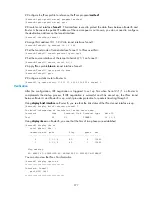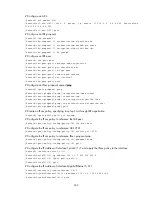
287
Figure 100
IKE exchange process in main mode
As shown in
, the main mode of IKE negotiation in phase 1 involves three pairs of messages:
•
SA exchange
—Used for negotiating the security policy.
•
Key exchange
—Used for exchanging the Diffie-Hellman public value and other values like the
random number. Key data is generated in this stage.
•
ID and authentication data exchange
—Used for identity authentication and authentication of data
exchanged in phase 1.
The main difference between the main mode and the aggressive mode is that the aggressive mode does
not provide identity protection and exchanges only three messages rather than three pairs. The main
mode provides identity protection but is slower.
Functions
IKE provides the following functions for IPsec:
•
Automatically negotiates IPsec parameters, such as the keys.
•
Performs DH exchange when establishing an SA, ensuring that each SA has a key independent of
other keys.
•
Automatically negotiates SAs when the sequence number in the AH or ESP header overflows,
ensuring that IPsec provides the anti-replay service normally by using the sequence number.
•
Provides end-to-end dynamic authentication.
•
Identity authentication and management of peers influence IPsec deployment. A large-scale IPsec
deployment needs the support of CAs or other institutes that manage identity data centrally.
















































